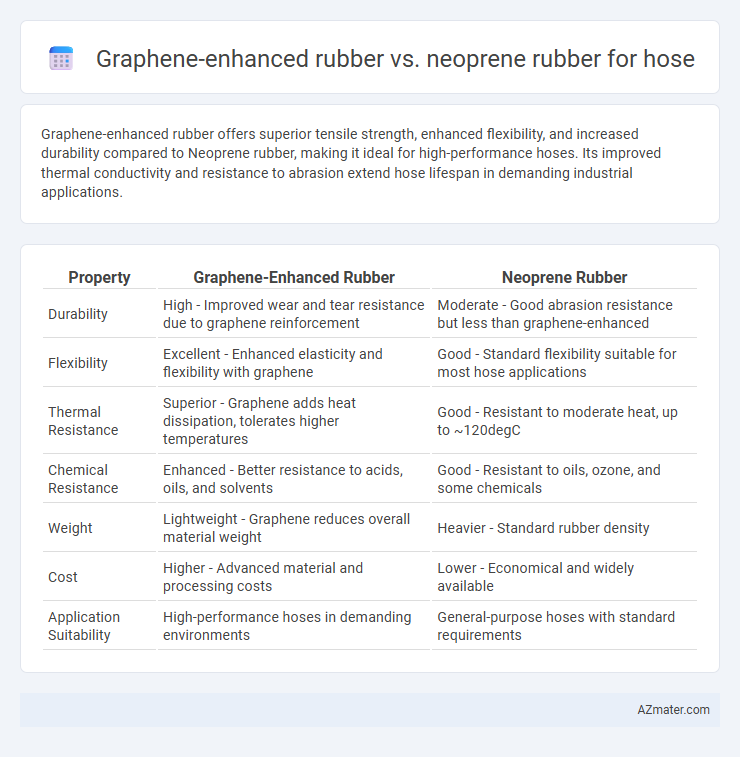Graphene-enhanced rubber offers superior tensile strength, enhanced flexibility, and increased durability compared to Neoprene rubber, making it ideal for high-performance hoses. Its improved thermal conductivity and resistance to abrasion extend hose lifespan in demanding industrial applications.
Table of Comparison
| Property | Graphene-Enhanced Rubber | Neoprene Rubber |
|---|---|---|
| Durability | High - Improved wear and tear resistance due to graphene reinforcement | Moderate - Good abrasion resistance but less than graphene-enhanced |
| Flexibility | Excellent - Enhanced elasticity and flexibility with graphene | Good - Standard flexibility suitable for most hose applications |
| Thermal Resistance | Superior - Graphene adds heat dissipation, tolerates higher temperatures | Good - Resistant to moderate heat, up to ~120degC |
| Chemical Resistance | Enhanced - Better resistance to acids, oils, and solvents | Good - Resistant to oils, ozone, and some chemicals |
| Weight | Lightweight - Graphene reduces overall material weight | Heavier - Standard rubber density |
| Cost | Higher - Advanced material and processing costs | Lower - Economical and widely available |
| Application Suitability | High-performance hoses in demanding environments | General-purpose hoses with standard requirements |
Introduction to Advanced Rubber Materials for Hoses
Graphene-enhanced rubber exhibits superior mechanical strength, thermal conductivity, and chemical resistance compared to conventional neoprene rubber, making it ideal for advanced hose applications. The integration of graphene nanoparticles improves durability and flexibility while reducing weight and enhancing resistance to abrasion and aging. These properties position graphene-enhanced rubber as a cutting-edge material for high-performance hoses in demanding industrial environments.
What is Graphene-Enhanced Rubber?
Graphene-enhanced rubber integrates graphene, a single layer of carbon atoms arranged in a hexagonal lattice, into traditional rubber compounds to significantly improve mechanical strength, flexibility, and thermal conductivity. This advanced composite material exhibits superior abrasion resistance and enhanced durability compared to conventional neoprene rubber, making it ideal for high-performance hose applications. Graphene's exceptional electrical and thermal properties also contribute to better heat dissipation and increased lifespan in demanding industrial environments.
Understanding Neoprene Rubber Properties
Neoprene rubber offers excellent chemical stability, oil resistance, and moderate weathering protection, making it a reliable choice for general-purpose hoses exposed to various environmental conditions. Its inherent flexibility, durability, and resistance to compression set ensure effective sealing and longevity under mechanical stress. While graphene-enhanced rubber improves strength and conductivity, neoprene's balanced performance in abrasion resistance and temperature tolerance remains critical in hose applications requiring consistent elasticity and environmental resilience.
Mechanical Strength Comparison: Graphene-Enhanced vs Neoprene Rubber
Graphene-enhanced rubber exhibits significantly higher mechanical strength than traditional neoprene rubber, offering improved tensile strength, abrasion resistance, and elasticity essential for high-performance hoses. The superior load-bearing capacity and enhanced durability of graphene-reinforced composites reduce wear and extend hose lifespan in demanding industrial environments. Neoprene rubber, while flexible and resistant to oils and weathering, generally lags behind in mechanical robustness compared to graphene-enhanced materials optimized for strength and longevity.
Chemical Resistance Performance in Hose Applications
Graphene-enhanced rubber exhibits superior chemical resistance compared to neoprene rubber, making it highly effective in hose applications exposed to aggressive chemicals and solvents. The incorporation of graphene nanoparticles improves the polymer matrix's barrier properties, reducing permeation and degradation caused by hydrocarbons, oils, and acids. Neoprene rubber, while offering moderate chemical resistance, often underperforms in harsh chemical environments where graphene-enhanced rubber maintains integrity and longevity.
Flexibility and Durability Analysis
Graphene-enhanced rubber exhibits superior flexibility compared to neoprene rubber, due to the unique lattice structure of graphene that allows for greater stretch and recovery without degradation. Durability analysis shows that graphene integration significantly improves resistance to wear, abrasion, and chemical exposure, extending hose lifespan beyond that of traditional neoprene. These properties make graphene-enhanced rubber an ideal choice for high-performance hoses requiring enhanced mechanical strength and prolonged service intervals.
Temperature Tolerance and Thermal Conductivity
Graphene-enhanced rubber exhibits superior temperature tolerance, maintaining structural integrity and flexibility in extreme ranges from -60degC to 200degC, outperforming neoprene rubber which typically withstands temperatures between -40degC and 120degC. The thermal conductivity of graphene-infused rubber significantly improves heat dissipation, reducing thermal degradation during high-temperature operations, while neoprene rubber has relatively low thermal conductivity, which can lead to localized overheating. This makes graphene-enhanced rubber ideal for hoses exposed to harsh thermal environments requiring enhanced durability and heat management.
Cost-Effectiveness and Manufacturing Considerations
Graphene-enhanced rubber offers superior tensile strength and durability compared to neoprene rubber, reducing maintenance costs and extending hose lifespan, which enhances cost-effectiveness over time. Manufacturing graphene-enhanced rubber requires advanced processing techniques and higher initial material costs, impacting upfront production expenses relative to the more established and widely available neoprene rubber. The trade-off between enhanced performance and initial manufacturing investment makes graphene-enhanced rubber ideal for applications demanding longevity and high performance, while neoprene remains a cost-efficient choice for standard hose requirements.
Environmental Impact and Sustainability Factors
Graphene-enhanced rubber hoses demonstrate superior environmental impact profiles by significantly reducing carbon emissions during production through enhanced durability and extended lifespan, lowering the frequency of replacements. Neoprene rubber, while widely used, involves more energy-intensive manufacturing processes and releases chlorinated compounds that pose environmental hazards during disposal. Sustainable hose solutions increasingly favor graphene-enhanced rubber due to its recyclability potential and reduced ecological footprint compared to traditional neoprene alternatives.
Choosing the Right Rubber: Graphene-Enhanced vs Neoprene for Hoses
Graphene-enhanced rubber offers superior strength, flexibility, and chemical resistance compared to traditional neoprene rubber, making it ideal for high-performance hoses used in extreme conditions. Neoprene rubber provides excellent durability, temperature resistance, and cost-effectiveness for general-purpose hoses in industrial and automotive applications. Selecting the right material depends on specific hose requirements such as exposure to abrasives, temperature extremes, and chemical environments.

Infographic: Graphene-enhanced rubber vs Neoprene rubber for Hose
 azmater.com
azmater.com